Joy Neal Kidney's Blog, page 40
March 30, 2023
Places along White Pole Road named in the “Leora Stories”
Fans of the “Leora stories” have already been traveling to see where some of the stories took place, or to find places connected with the Clabe and Leora Wilson and their family. Since many of the stories are from Dexter and Stuart, here’s some help with places along White Pole Road.
Stuart
Depot
The Goffs and the Wilsons rode the Liza Jane train many times between Stuart and Guthrie Center. The Stuart Depot, right along White Pole Road, has been renovated and is in use for local activities. Commemorative bricks were sold as a fundraiser. Four Wilson bricks are part of the display near the depot. Address: 1193-1199 Front St, Stuart, IA 50250
Dexter, Iowa
 “Grandmother’s House” still stands, along White Pole Road and across from the Dexter Park. A monument near the sidewalk names Dexter men who were combat casualties.
“Grandmother’s House” still stands, along White Pole Road and across from the Dexter Park. A monument near the sidewalk names Dexter men who were combat casualties.
The Dexter Methodist Church, where Leora and her mother were baptized, is two blocks south of “Grandmother’s House.”
The Dexter water tower, which Delbert climbed to tie his class colors, is easy to find. (Story on page 66 of Leora’s Dexter Stories: The Scarcity Years of the Great Depression)
The Dexter Public Library, along Marshall Street, is in the same place where Clabe Wilson worked on the 1939 WPA project to remodel it. (see pages 81 and 82) Earlier the doctors’ office was in that building. Doris saw Clyde Barrow’s brother Buck and his wife Blanche come out bandaged up after the Dexfield Park shootout in 1933.
A block south and across the street is the Dexter Museum, where there is a large display about the Wilson family. They also own the Mrs. Potts sadiron which belonged to Leora’s mother, Laura Goff when she lived at Dexter.
The 1916 Dexter Community Building, where the Wilson kids played basketball, is one block west of the library. It’s on the National List of Historic Places.
Drew’s Chocolates has been in business since 1927. (see page 142) It’s still a popular stop along White Pole Road at the west edge of Dexter.
There’s a marker for Dexfield Park, where the 1933 shootout with Bonnie and Clyde happened, is a couple of miles north of Drew’s on Dexfield Road.
Please check your local library for copies of Leora’s Early Years: Guthrie County Roots and Leora’s Dexter Stories: The Scarcity Years of the Great Depression. I hope your high school students will enjoy the short chapters in both of these books!
March 29, 2023
What Could be Built from an Old Pump Organ?
While working on Leora’s Dexter Stories, I became acquainted with Mary Wilt, a neighbor of the Wilsons. Mrs. Wilt knew that Leora Wilson could play the piano and that the Wilson girls, Doris and Darlene, were in the Dexter band. In 1933, she said they may as well have her pump organ since she didn’t play it anymore.
In those days, the Wilson family was so strapped for life’s necessities, there was hardly money for extras. They even needed to burn furniture so they could heat their rented house, but the organ survived.
 It survived until the spring of 1937, when Dale Wilson needed a project for manual training. He transformed part of the organ into a handsome radio table. His twin sister, Darlene, is wearing a dress she’d made in home economics class.
It survived until the spring of 1937, when Dale Wilson needed a project for manual training. He transformed part of the organ into a handsome radio table. His twin sister, Darlene, is wearing a dress she’d made in home economics class.
No one knows what eventually happened to Dale’s masterpiece. Surely his mother kept it through the decades. But we still have a photo and the poignant story of how one family in poverty made do, and were also ministered to by a wonderful neighbor who spoke with a German accent.
March 24, 2023
County Champs In Spite of a Broken Shoestring
1939 Dallas County Champs
Dexter had a great boys’ basketball team that year. That was heartening for the whole town of nearly 760 souls, which was still in the grips of the Great Depression. It certainly boosted the spirits of Wilson family since Dale, a senior, was on the first team.
 Dexter boys’ basketball team, 1939. They won the County Championship that year. Back: Coach Carl Stoddard, Warren Harris, John Shepherd, Charles Lee, Howard Kirkman, Dale Wilson, Victor Zike, Charles Thompson. Front: Bill Myers, Lyle Thompson, Danny Wilson, Max Sutherland, Lynford Bebout, Jim McMenamin. Four of these boys would killed in WWII: Lynford Bebout, Lyle Thompson, Dale Wilson, and Danny Wilson.
Dexter boys’ basketball team, 1939. They won the County Championship that year. Back: Coach Carl Stoddard, Warren Harris, John Shepherd, Charles Lee, Howard Kirkman, Dale Wilson, Victor Zike, Charles Thompson. Front: Bill Myers, Lyle Thompson, Danny Wilson, Max Sutherland, Lynford Bebout, Jim McMenamin. Four of these boys would killed in WWII: Lynford Bebout, Lyle Thompson, Dale Wilson, and Danny Wilson.When a shoestring broke in those days, the owner tied it back together, each time ending up with a shorter strong. Dale’s ruptured during a game. Dexter took a time-out so he could take care of it, but it’d become so short, there was nothing left to make another knot. Someone on the opposing team handed over a shoestring so he could finish the game.
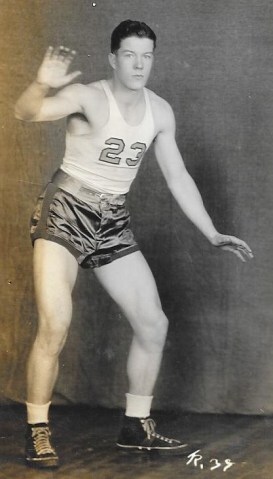
A blizzard set in during the last game of the Dallas County Championship tournament, which was held at Perry, at the opposite side of the county. Folks at home worried that the team might try to make it back home during the storm, but someone sent word that they were staying overnight at the Perry schoolhouse.
And that the Dexter boys had won the tournament!
 Victor Zike, Warren Harris, Cahrles Lee, John Shepherd, Dale Wilson
Victor Zike, Warren Harris, Cahrles Lee, John Shepherd, Dale WilsonDallas County News, Feb. 15, 1939–”Dexter Boys Team and DeSoto Girls Are County Champs–Dexter’s brilliant boys’ team eked out a 21-20 victory over a strong Minburn team in the closing minutes of the championship game. It was a thrilling and exciting game all the way, and the packed house that saw it certainly got their money’s worth. A crowd estimated to be over 1000 people saw the final games.
“Dexter’s ‘Five Iron Men’ waded through all competition and then turned on the heat in the closing minutes in the last game to beat Minburn by one point. To Victor Zike and ‘Homer’ Harris go credit for the championship as these two hit the hoop from all angles and played a fine brand of basketball throughout the whole tourney. [Charles] Lee, [John] Shepherd and [Dale] Wilson were the other members of the team, and they, too, counted in the pinches and played great ball.”
“1939 Dallas County Champions–The local boys basketball team won a hard fought game Saturday evening at the County Tournament at Perry from the Minburn quint to win the Championship. Boy, what a game. [John] Shepherd dived half way across the floor to grab the ball and save the opponents from a sure field goal. [Charles] Lee played superb ball, grabbing the ball off the bangboard many times. And [Dale] Wilson, well, if you saw that game, you know the swell game he played–a real defense man.”
The story of the broken shoestring came from my Uncle John Shepherd, who married Dad’s sister Nadine Neal. Uncle John was also on this winning team, the one who “dived half way across the floor to grab the ball.”
This is Chapter 45 in Leora’s Dexter Stories: The Scarcity Years of the Great Depression.
March 22, 2023
Leora, the Family Barber
Leora Goff became her brothers’ barber because they didn’t want their father clipping their hair too short. With seven brothers, it was a good thing they didn’t all want haircuts the same day. I didn’t find any photos of Leora’s brothers without their caps.
During the Great Depression, young Darlene Wilson babysat for Zedonna and M.M. Neal, watching their three sons–Rawson, Jimmie, and Richard. Zedonna would send them down to Leora for their haircuts, usually on weekends, when she was especially busy. But Zedonna Neal was a teacher, so it was welcome income for Leora.
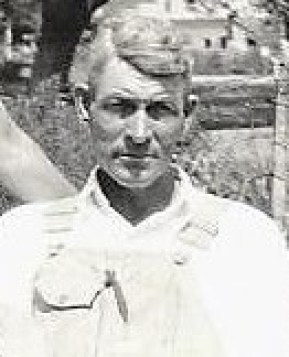 On of the only few photos of Clabe Wilson without a hat or cap. July 22, 1934, Dexter
On of the only few photos of Clabe Wilson without a hat or cap. July 22, 1934, DexterLeora also barbered for her husband Clabe and her own children. After the older two were in the Navy, she remarked in one letter that Clabe wanted a haircut, that he thought it was too long, although she didn’t think it was.
1929. During the school year, cousins Maxine and Merrill lived in the big Goff house. Merrill was in Danny’s class in school and Maxine was the same age as Darlene, so they spent a lot of time together.
One day Maxine came wailing to the Wilsons’ kitchen door. “What’s wrong, Maxine?” Leora could see that her niece had mighty short hair.
“Grandpa chopped off all my hair!” Maxine swiped at her tears. “I hate it!”
“Well, it looks like he gave you a boybob. It’s the new thing, Maxine. I’ll bet Darlene would like her hair cut the same new way, wouldn’t you, Darlene?”
“Yes, then we can be alike.”
“Maxine, let me even yours up a bit first.” Leora gathered up her scissors and comb, took a chair to the backyard, and set to work. Two nine-year-old girls were soon showing off their twin boybobs.
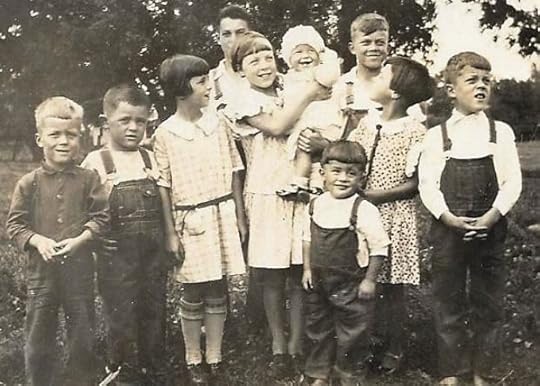
Wilson and Goff cousins: Danny Wilson, Merrill (I’ll bet his Grandpa Sherd clipped his hair) and Maxine Goff, Delbert (behind) and Doris Wilson with baby cousin, Connie Goff. Junior, Donald, Darlene, and Dale Wilson. Look at all the haircuts Leora was in charge of, plus the three Neal boys!
Remember the time when Clabe became Leora’s barber?
Stories from Leora’s Early Years: Guthrie County Roots and Leora’s Dexter Stories: The Scarcity Years of the Great Depression
March 20, 2023
Two Homes Designed by Women–A President’s Wife and My Mother
Palo Alto, California

The Lou Henry and Herbert Hoover House, a National Historic Landmark, is a large, rambling International style house, resembling “blocks piled up.” It was designed by Lou Henry Hoover, wife of Herbert Hoover, 31st President of the United States. Herbert Hoover’s contribution was to order that the home be fireproof, and the walls were constructed of hollow tiles. Built from 1919 to 1920, the house was the couple’s first and only permanent residence.
It was here that Hoover awaited the Presidential election returns in 1928, when he won against Alfred E. Smith, and 1932, when he lost the election to Franklin Delano Roosevelt. After Lou’s death in 1944, her husband deeded the house to Stanford University to serve as a home for university professors.
Herbert Hoover, born in West Branch, Iowa in 1874, was a member of the first class of Leland Stanford, Jr. University. Opened in 1891 by former California Governor Leland Stanford and his wife in memory of their son, the University was located in Palo Alto, California, 30 miles south of San Francisco. Studying geology, Hoover met fellow student Lou Henry in a geology lab. Lou Henry, also born in Iowa in 1874, had moved to Monterey, California, with her family in 1884. She entered Stanford University in 1894.
Old Creamery Road, Dexter, Iowa
My mother designed the house that replaced the original one on the farm, along Old Creamery Road.
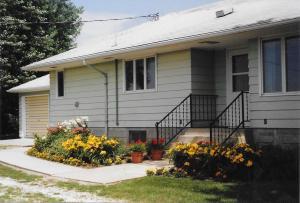
 Mom’s plan for the front turned out the way she wanted it. She described landscaping as well.
Mom’s plan for the front turned out the way she wanted it. She described landscaping as well.

On another sheet of graph paper, Mom had plotted the area south of the house that includes a shed. Dad added electrical lines, which run from the shed to the house and to a grain-drying bin, and also the pipe from the farm well to the house. He used Mom’s specs and measurements for the new house. Because Dad was also a farmer, planting and harvesting came first. We rented a house three miles away. It had running water but no indoor bathroom. Yes, an outhouse.
We moved there when I was a senior in high school, so I mostly escaped the outhouse for the next couple of years. It took that long for Dad and Uncle Bill to build the house.
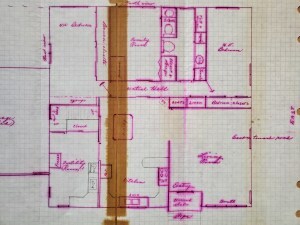
The living area is basically square, with only two bedrooms, both with plenty of closet space. Another space included a couch which could be used by a guest, usually Grandma Leora. It has a bath and a half, with a large linen closet in the hallway. I’ve heard that adults tend to collect what they lacked as children. Mom loved having enough beautiful sheets and colorful towels, what she longed for during the Great Depression. She enjoyed giving linens as gifts, even for her own mother (Leora).
As amazing as it was for Lou Henry Hoover to design her own house, I’m even more surprised that Mom’s plans became her little green farm home.
—–
Here’s the story about my beloved but rickety farm house Dad had to tear down to build Mom’s dream home.
March 17, 2023
Why did Georgia Wilson give up her first son so readily?
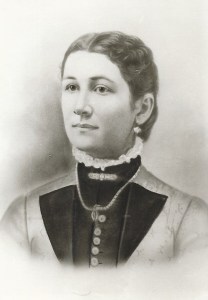 I believe Georgia Ann Wilson is my only divorced ancestor, in an era when it was uncommon.
I believe Georgia Ann Wilson is my only divorced ancestor, in an era when it was uncommon.
She was one of four daughters of Samuel and Martha Williams, who homesteaded in Jackson Township, Guthrie County, Iowa, in 1854–along with Samuel’s parents. They were early and devout members of the Morrisburg Christian Church.
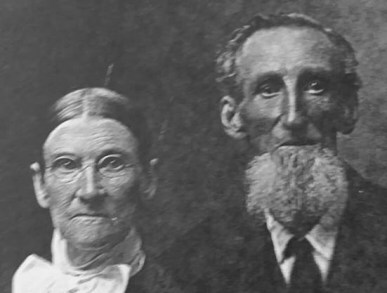 Martha and Samuel Williams
Martha and Samuel WilliamsGeorgia Ann married a man named Frank Davis when she was 17. Baby Fred Davis was born the next year. His parents divorced. No clues as to why, only guesses, but Georgia and little Fred probably ended up living with her folks.
Five years later, she married Daniel Wilson, four years her junior. Dan evidently didn’t want to raise another man’s son, so Fred grew up with his grandparents.

But while working with early Iowa ancestors for Leora’s Early Years: Guthrie County Roots, I noticed that Samuel and Martha Williams had had a son born first, probably in Ohio, who died at the age of 1. His name was Roy.
They came to Iowa in 1855 with a two year old daughter, Emma. Three more daughters were born in Guthrie County, Iowa–Serepta Ann, Edna Alice, and Georgia Ann.
Perhaps it was her parent’s idea to let Georgia start over again with a new family. What are your thoughts? Perhaps this gave them a chance to raise a son, which had been denied them with the death of their firstborn.
Georgia Ann Wilson is buried in Guthrie County’s Morrisburg Cemetery, along with her first child (Fred Davis), her parents, Williams grandparents, and many other relatives.
Leora’s Early Years: Guthrie County Roots
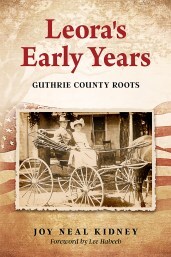
The photo on the cover is of newlyweds Clabe and Leora Wilson in front of Georgia Wilson’s house, which still stands, in Panora.
March 15, 2023
The Model T Truck became “Roadster”
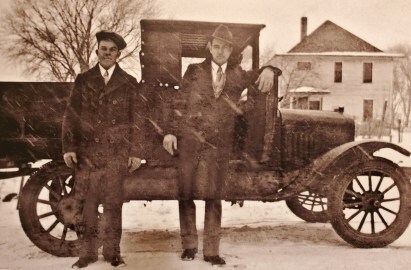 Donald and Delbert Wilson, January 1934, Dexter, Iowa. “Grandmother’s house” is in the background.
Donald and Delbert Wilson, January 1934, Dexter, Iowa. “Grandmother’s house” is in the background.This photo of the two oldest Wilson brothers was featured in the Rewind section of the December/January issue of Our Iowa magazine.
That Model T Ford pickup became the Wilson family “roadster” later that year, 1934. Wouldn’t the Wilson family be surprised that this photo became part of the cover of Leora’s Dexter Stories: The Scarcity Years of the Great Depression!
 Clabe, Dale, Danny, and Junior with the “roadster.” Their pet squirrel Rusty is on the fender. Dexter, 1934
Clabe, Dale, Danny, and Junior with the “roadster.” Their pet squirrel Rusty is on the fender. Dexter, 1934The original snapshot of the truck was so uneven that I had Alexander’s Photo restore it. It’s the only picture of the entire truck, even more precious because Donald and Delbert had just been to Des Moines to enlist in the Navy. They’d finally have enough to eat as well as the ability to send a little money home to help support their folks, Clabe and Leora Wilson, and five siblings during those Depression years.

Clabe Wilson, who still had no job, sold the Model T truck/roadster toward the end of 1934, so they’d have that money to live on.
When the Wilsons left Dexter five years later, they still had no vehicle. Living in a small town, they walked nearly everywhere. When Clabe found a job out of town, such as at the brick and tile works in Redfield, he paid the driver for a ride.
 The roadster ended up on the cover.
The roadster ended up on the cover.Some of the Wilson stories from those “Scarcity Years of the Great Depression” came from letters and photos that began to flow between the “Navy boys” and the family at home, including fun letters from the younger kids.
March 13, 2023
Immigrant Patriot by Craig Matthews
The Book
 One family’s struggle for freedom and faith in a world gone mad.
One family’s struggle for freedom and faith in a world gone mad.
The call of freedom has propelled millions of immigrants to journey thousands of miles from all corners of the globe to come to America over the last four hundred years.
This story details the incredible cost that some are willing to pay to drink from freedom’s fountain.
Craig Matthews’s grandfather crossed the Atlantic Ocean seven times to come to America. He fought in a global war, and nearly died in combat in the French countryside, wearing the uniform of an American.
His grandmother, at nine years old, came to the States with her family and within three weeks of arrival her father was dead. Her mother was pressured to remarry by the leader of their secretive church. She married seven years later, at sixteen, to escape her abusive stepfather, only to walk into another devastating tragedy.
Shortly thereafter the worldwide pandemic broke out and life got even more challenging.
This is their unbelievable tale.
In the end, instead of becoming bitter, the epic struggles transformed both of them from isolated Immigrants, to genuine Patriots. The freedom and faith they fought for, changed them and through the hardship came the blessing. Those precious gifts were passed down to Craig Matthews who now shares their stories.
The Author
 Craig Matthews is: A son of two parents. Sibling to three. Husband to one. Father of three. Grandfather of seven. Author of four books. Herder of nine chickens and a barn cat named Moo. One creative soul.
Craig Matthews is: A son of two parents. Sibling to three. Husband to one. Father of three. Grandfather of seven. Author of four books. Herder of nine chickens and a barn cat named Moo. One creative soul.
Craig Matthews loves: Jesus. Connie. Six kids. Seven grandkids. His big family. A good story. People in general. Pizza in particular. Nature. History. Adventure of all kinds. Sunsets. Detroit sports teams. Living at the end of a dead end road. Islands. Laughter, and a particular historical document dated 9-17-1787.
My Thoughts
What an incredible weaving of the immigrant journeys of a young couple, from Scotland and Italy, who meet in Utah after he survives WWI and the influenza pandemic. By then, she is a young widow, who has lost a young brother, her father, her husband in the war, and another brother to the pandemic.
But they have much more to face, from the deception and destruction of a rampant secretive religion. Remarkably, they escape and find redemption. This is the almost unbelievable story of the author’s grandparents, written as a novel.
Here’s a 30-minute video of Craig talking about the background of the book. I’m a fan of backstories!
You might like to check out his website.
March 10, 2023
When Winter Came: A Country Doctor’s Journey to Fight the Flu Pandemic of 1918

Maintain isolation – practice good hygiene – wear a mask – be kind. We all know these methods of fighting COVID-19, but this prescription comes from the 1918 experience of Dr. Pierre Sartor, who battled the worldwide influenza pandemic in his small town of Titonka, Iowa.
Dr. Sartor wrote an inspiring first-person account which lay forgotten in a lockbox of family artifacts until it was discovered decades later by his granddaughter, Beth Obermeyer. Beth knew her grandfather through her teenage years and grew up absorbing family stories. Based upon Dr. Sartor’s memoir and her years of research, she vividly reconstructs his life from childhood in Luxembourg through medical training in America to the early months of the influenza pandemic in small town Iowa.
Dr. Sartor was so successful in treating his patients that he later was named General Practitioner of the Year by the Iowa State Medical Society. He established a close collaboration with Mayo Clinic, about 130 miles away.
Beth’s story is rooted in a certain time and place. Yet it speaks across generations to the qualities that make a compassionate, skilled physician – a compelling example of doing the best of things in the worst of times. Because, when winter comes, we all want a doctor like Pierre Sartor.
 The Author
The Author
Beth Obermeyer used her journalism degree and a lifetime of dance and music to start her own event/public relations company. On the faculty of the Minnesota Dance Theatre, Beth soloed with the Minnesota Orchestra in the Tap-Dance Concerto as well as opposite Christopher Plummer, Gregory Hines, and Garrison Keillor, all in Minnesota performances. Beth’s journalism degree is from Iowa State University where she was a member of Kappa Alpha Theta sorority.
My Thoughts
When Winter Came is an immigrant story, of a sickly boy who was eventually healed. That experience led to medical school in a big city in his new country, but he longed to serve in a small town setting, using the same kindly medical care he’d experienced.
Dr. Pierre Sartor was new in his northern Iowa town when the influenza pandemic broke out. He forged a partnership with what is now Mayo Clinic, which was beneficial his entire career. The author’s father, who at age 12 began driving his father to patients, also became a doctor. Dr. Pierre Sartor’s box of treasures was passed to his son, who later gave it to the author, setting her on an exciting journey of discovery. She reveals even more of that at the end of the book.
An important chapter in Iowa history, medical history, and of a well-loved Iowa country doctor, who had immigrated from Luxembourg. A beautiful book.
The author’s recent interview by John Busbee on The Culture Buzz.
Her website.
March 8, 2023
Reflections Along the White Pole Road

The White Pole Road is the original dirt road that began in the Midwest between Omaha and Des Moines in the early 1900s. It went on to become the first certified state route stretching from Davenport to Omaha. As a tribute to that history, more than 700 poles have been repainted white along the 26-mile original byway that runs parallel to Interstate 80.
In the book Reflections Along the White Pole Road, Route 66-like diversions offer travelers a look through the lens of photographer, Tim Florer, along with original historical photographs and recollections by local residents. The adventures along White Pole Road include Jesse James, Bonnie and Clyde, the great flood, and the National Plowing Match of 1948 with an address by President Harry S. Truman.
A piece of history, preserved by the White Pole Road Association.
My Reflections: Before Interstate 80 was built across Iowa, White Pole Road had plenty of traffic through town. But these days, the White Pole Road Development Corporation keeps those poles painted white between Dexter and Adair, to promote tourism for five small towns with populations of 348 in the smallest (Menlo) to 1695 in the largest (Stuart).
This terrific book has photos and memories of back in the day as well as today. A keepsake.
Copies may be ordered through Amazon. Locally, they are available at any bank along White Pole Road (Dexter, Stuart, Menlo, Casey, and Adair), Stuart Flowers & Gifts, the Dexter Historical Museum and Drew’s Chocolates in Dexter.
There’s a photo of the contraption that paved White Pole Road/Great White Way for the first time through Dexter in 1929 in Chapter 11 of Leora’s Dexter Stories: The Scarcity Years of the Great Depression.



